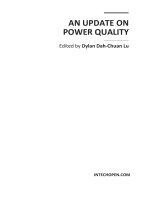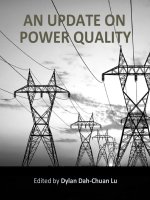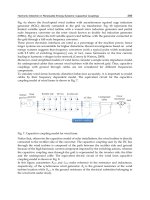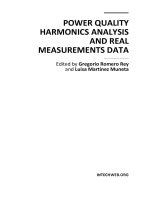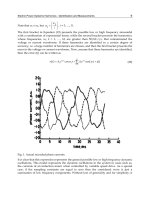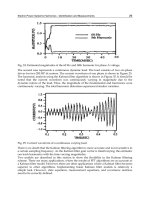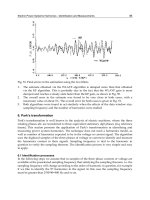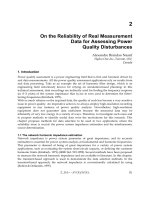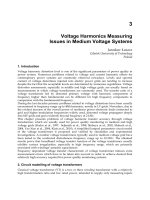Co-phase Traction Power Supply with Railway Hybrid Power Quality Conditioner (2019)
Bạn đang xem bản rút gọn của tài liệu. Xem và tải ngay bản đầy đủ của tài liệu tại đây (15.6 MB, 242 trang )
Keng-Weng Lao · Man-Chung Wong
NingYi Dai
Co-phase Traction
Power Supply with
Railway Hybrid
Power Quality
Conditioner
Co-phase Traction Power Supply with Railway
Hybrid Power Quality Conditioner
Keng-Weng Lao Man-Chung Wong
NingYi Dai
•
Co-phase Traction Power
Supply with Railway Hybrid
Power Quality Conditioner
123
Keng-Weng Lao
Department of Electrical and Computer
Engineering
University of Macau
Macau
China
NingYi Dai
Department of Electrical and Computer
Engineering
University of Macau
Macau
China
Man-Chung Wong
Department of Electrical and Computer
Engineering
University of Macau
Macau
China
ISBN 978-981-13-0437-8
ISBN 978-981-13-0438-5
/>
(eBook)
Library of Congress Control Number: 2018940417
© Springer Nature Singapore Pte Ltd. 2019
This work is subject to copyright. All rights are reserved by the Publisher, whether the whole or part
of the material is concerned, specifically the rights of translation, reprinting, reuse of illustrations,
recitation, broadcasting, reproduction on microfilms or in any other physical way, and transmission
or information storage and retrieval, electronic adaptation, computer software, or by similar or dissimilar
methodology now known or hereafter developed.
The use of general descriptive names, registered names, trademarks, service marks, etc. in this
publication does not imply, even in the absence of a specific statement, that such names are exempt from
the relevant protective laws and regulations and therefore free for general use.
The publisher, the authors and the editors are safe to assume that the advice and information in this
book are believed to be true and accurate at the date of publication. Neither the publisher nor the
authors or the editors give a warranty, express or implied, with respect to the material contained herein or
for any errors or omissions that may have been made. The publisher remains neutral with regard to
jurisdictional claims in published maps and institutional affiliations.
Printed on acid-free paper
This Springer imprint is published by the registered company Springer Nature Singapore Pte Ltd.
part of Springer Nature
The registered company address is: 152 Beach Road, #21-01/04 Gateway East, Singapore 189721,
Singapore
This book is dedicated to my family,
supervisors and friends. It would not have
been completed without their support. I would
also like to dedicate the book to all those who
are doing research on railway power and
power quality compensation.
Contents
1 Introduction . . . . . . . . . . . . . . . . . . . . . . . . . . . . . . . . . . . . . . . . . . .
1.1 Overview and Introduction . . . . . . . . . . . . . . . . . . . . . . . . . . . . .
1.2 Development of Electrified Railway Power Supply Mode . . . . . . .
1.2.1 Alternating Current (ac) Traction Power . . . . . . . . . . . . . .
1.2.2 Direct Current (dc) Traction Power . . . . . . . . . . . . . . . . . .
1.3 Worldwide Development of Electrified Railway . . . . . . . . . . . . . .
1.3.1 China . . . . . . . . . . . . . . . . . . . . . . . . . . . . . . . . . . . . . . .
1.3.2 Japan . . . . . . . . . . . . . . . . . . . . . . . . . . . . . . . . . . . . . . .
1.3.3 America . . . . . . . . . . . . . . . . . . . . . . . . . . . . . . . . . . . . .
1.3.4 Europe . . . . . . . . . . . . . . . . . . . . . . . . . . . . . . . . . . . . . .
1.4 Traction Power Supplies . . . . . . . . . . . . . . . . . . . . . . . . . . . . . . .
1.4.1 Various Traction Power Structures . . . . . . . . . . . . . . . . . .
1.4.2 Traction Power Quality Problems . . . . . . . . . . . . . . . . . . .
1.4.3 Existing Solutions for Traction Power Quality Problems . . .
1.5 Various Power Quality Compensators . . . . . . . . . . . . . . . . . . . . .
1.5.1 Fixed Shunt Capacitor Bank . . . . . . . . . . . . . . . . . . . . . . .
1.5.2 Passive Filter . . . . . . . . . . . . . . . . . . . . . . . . . . . . . . . . . .
1.5.3 Static Var Compensator (SVC) . . . . . . . . . . . . . . . . . . . . .
1.5.4 Static Synchronous Compensator (STATCOM) . . . . . . . . .
1.5.5 Dynamic Voltage Restorer (DVR) . . . . . . . . . . . . . . . . . .
1.5.6 Unified Power Quality Compensator (UPQC) . . . . . . . . . .
1.5.7 Hybrid Active Power Filter (HAPF) . . . . . . . . . . . . . . . . .
1.5.8 Compensators Applied in Traction Power . . . . . . . . . . . . .
1.5.9 Comparisons Among Various Compensators . . . . . . . . . . .
1.6 Recent Research Developments on Traction Power Supply
System and Its FACTS Compensation Devices . . . . . . . . . . . . . . .
1.6.1 Recent Research on Traction Power Supply System . . . . . .
1.6.2 Recent Researches on Traction FACTS
Compensation Devices . . . . . . . . . . . . . . . . . . . . . . . . . . .
1
1
4
4
4
5
5
5
5
6
6
6
9
13
15
16
16
17
18
19
19
20
21
23
24
24
26
vii
viii
Contents
1.6.3 Research Development of Co-phase Traction Power with
Railway HPQC . . . . . . . . . . . . . . . . . . . . . . . . . . . . . .
1.7 Summary . . . . . . . . . . . . . . . . . . . . . . . . . . . . . . . . . . . . . . . .
1.8 Book Organization . . . . . . . . . . . . . . . . . . . . . . . . . . . . . . . . .
References . . . . . . . . . . . . . . . . . . . . . . . . . . . . . . . . . . . . . . . . . . .
.
.
.
.
.
.
.
.
2 Co-phase Traction Power Supply with Railway HPQC: Modeling,
Control, and Advantages Over System with RPC . . . . . . . . . . . . . . .
2.1 Introduction . . . . . . . . . . . . . . . . . . . . . . . . . . . . . . . . . . . . . . . .
2.2 System Configuration of Co-phase Traction Power Supply
with Railway HPQC . . . . . . . . . . . . . . . . . . . . . . . . . . . . . . . . . .
2.2.1 Circuit Topology . . . . . . . . . . . . . . . . . . . . . . . . . . . . . . .
2.2.2 System Parameters . . . . . . . . . . . . . . . . . . . . . . . . . . . . . .
2.3 Co-phase Traction Power Quality Problem Modeling . . . . . . . . . .
2.3.1 System Unbalance and Negative Sequence Components . . . .
2.3.2 System Source Reactive Power and Power Factor . . . . . . .
2.3.3 System Source Harmonics and Nonlinearity . . . . . . . . . . .
2.4 Power Quality Compensation in Co-phase Traction Power . . . . . .
2.4.1 Fundamental Compensation: System Unbalance
and Reactive Power . . . . . . . . . . . . . . . . . . . . . . . . . . . . .
2.4.2 Harmonic Compensation: System Source Harmonics . . . . .
2.4.3 Comprehensive Compensation Control Algorithm . . . . . . .
2.4.4 Further Analysis of Co-phase Power Quality
Compensation Algorithm . . . . . . . . . . . . . . . . . . . . . . . . .
2.5 Co-phase Traction Power Quality Compensation Control
Block Diagram . . . . . . . . . . . . . . . . . . . . . . . . . . . . . . . . . . . . . .
2.5.1 Single-Phase Instantaneous Pq Computations . . . . . . . . . .
2.5.2 Computation of Required Active and Reactive
Compensation Power . . . . . . . . . . . . . . . . . . . . . . . . . . . .
2.5.3 Determination of Required Compensation Current . . . . . . .
2.5.4 Hysteresis PWM Controller to Generate
PWM Signals . . . . . . . . . . . . . . . . . . . . . . . . . . . . . . . . .
2.6 Co-phase Traction Power System with Different
Compensation Devices . . . . . . . . . . . . . . . . . . . . . . . . . . . . . . . .
2.6.1 Conventional System with Inductive-Coupled RPC . . . . . .
2.6.2 Novel System with Capacitive-Coupled HPQC . . . . . . . . .
2.7 System Analysis and Comparisons Between Conventional
RPC and Novel Railway HPQC . . . . . . . . . . . . . . . . . . . . . . . . .
2.7.1 Reduction in Operation Voltage and Inverter
Capacity Rating . . . . . . . . . . . . . . . . . . . . . . . . . . . . . . . .
2.7.2 Further Analysis on Reduction Criteria . . . . . . . . . . . . . . .
2.8 Summary . . . . . . . . . . . . . . . . . . . . . . . . . . . . . . . . . . . . . . . . . .
References . . . . . . . . . . . . . . . . . . . . . . . . . . . . . . . . . . . . . . . . . . . . .
28
30
31
32
37
37
38
38
38
40
41
42
42
43
43
46
46
47
49
49
51
52
52
53
53
54
56
56
61
63
64
Contents
3 Minimum Operation Voltage Design of Co-phase Traction Power
with Railway HPQC for Steady Rated Load . . . . . . . . . . . . . . . . . .
3.1 Introduction . . . . . . . . . . . . . . . . . . . . . . . . . . . . . . . . . . . . . . . .
3.2 Relationship Between Co-phase Traction Power Quality
Operation Voltage Rating and Other Parameters . . . . . . . . . . . . . .
3.2.1 Conventional System with RPC . . . . . . . . . . . . . . . . . . . .
3.2.2 Novel System with Railway HPQC . . . . . . . . . . . . . . . . .
3.3 Minimum Operation Voltage Rating Design
(Fundamental Compensation) . . . . . . . . . . . . . . . . . . . . . . . . . . .
3.3.1 Conventional RPC Design (Fundamental Compensation) . . .
3.3.2 Novel Railway HPQC Design (Fundamental
Compensation) . . . . . . . . . . . . . . . . . . . . . . . . . . . . . . . .
3.3.3 Reduction in Operation Voltage Rating
(Fundamental Compensation) . . . . . . . . . . . . . . . . . . . . . .
3.4 Minimum Operation Voltage Rating Design
(Harmonic Compensation) . . . . . . . . . . . . . . . . . . . . . . . . . . . . . .
3.4.1 Conventional RPC Design (Harmonic Compensation) . . . .
3.4.2 Novel Railway HPQC Using Traditional HAPF
Design (Harmonic Compensation) . . . . . . . . . . . . . . . . . .
3.4.3 Railway HPQC Using New Design Method
(Harmonic Compensation) . . . . . . . . . . . . . . . . . . . . . . . .
3.4.4 Reduction in Operation Voltage Rating
(Harmonic Compensation) . . . . . . . . . . . . . . . . . . . . . . . .
3.5 Novel Vac Phase and Vbc Phase Coupled Impedance Design . . . . .
3.5.1 Vac Phase Coupled Impedance . . . . . . . . . . . . . . . . . . . . .
3.5.2 Vbc Phase Coupled Impedance . . . . . . . . . . . . . . . . . . . . .
3.6 Comprehensive Design Procedure for Minimum Railway HPQC
Operation Voltage . . . . . . . . . . . . . . . . . . . . . . . . . . . . . . . . . . .
3.7 Simulation Study . . . . . . . . . . . . . . . . . . . . . . . . . . . . . . . . . . . .
3.7.1 System Performance Without Any Compensation . . . . . . .
3.7.2 System Performance with Conventional RPC
Compensation (Vdc = 42 kV) . . . . . . . . . . . . . . . . . . . . . .
3.7.3 System Performance with Railway HPQC Compensation
(Traditional HAPF Design) (Vdc = 20 kV) . . . . . . . . . . . . .
3.7.4 System Performance with Railway HPQC Compensation
(New LC Filter Design) (Vdc = 18.7 kV) . . . . . . . . . . . . . .
3.7.5 Simulation Summary and Further Comparison . . . . . . . . . .
ix
65
65
65
66
66
67
68
72
75
76
76
79
85
88
90
90
90
91
93
94
94
95
96
97
x
Contents
3.8 Experimental Verifications . . . . . . . . . . . . . . . . . . . . . . .
3.8.1 System Performance Without Any
Compensation Device . . . . . . . . . . . . . . . . . . . . .
3.8.2 System Performance with Conventional RPC
Compensation (Vdc = 80 V) . . . . . . . . . . . . . . . . .
3.8.3 System Performance with Novel Railway HPQC
(Traditional Harmonic Filter Design) (Vdc = 42 V)
3.8.4 System Performance with Novel Railway HPQC
Compensation Under New Harmonic Filter Design
(Vdc = 38 V) . . . . . . . . . . . . . . . . . . . . . . . . . . . .
3.9 Summary . . . . . . . . . . . . . . . . . . . . . . . . . . . . . . . . . . . .
References . . . . . . . . . . . . . . . . . . . . . . . . . . . . . . . . . . . . . . .
......
99
......
99
. . . . . . 100
. . . . . . 102
. . . . . . 104
. . . . . . 109
. . . . . . 111
4 Various Design Techniques of Co-phase Traction Power
with Railway HPQC for Varying Load . . . . . . . . . . . . . . . . . . . . .
4.1 Introduction . . . . . . . . . . . . . . . . . . . . . . . . . . . . . . . . . . . . . .
4.2 Requirement of Railway HPQC Operation Voltage
According to Loading Condition . . . . . . . . . . . . . . . . . . . . . . .
4.2.1 Load Variations and Change . . . . . . . . . . . . . . . . . . . .
4.2.2 Operation Voltage Requirement . . . . . . . . . . . . . . . . . .
4.3 Enhancing Railway HPQC Compensation Capability by
Increasing Operation Voltage (Based on Rated Coupled
Impedance Design) . . . . . . . . . . . . . . . . . . . . . . . . . . . . . . . . .
4.3.1 Railway HPQC Operation Voltage Requirement
Based on Load Condition Variations . . . . . . . . . . . . . . .
4.3.2 Relationship Between Operation Voltage Rating
and Compensation Capability . . . . . . . . . . . . . . . . . . . .
4.3.3 Comprehensive Design Procedure for Railway HPQC
with Enhanced Compensation Capability . . . . . . . . . . . .
4.3.4 Simulation Study . . . . . . . . . . . . . . . . . . . . . . . . . . . . .
4.3.5 Experimental Results . . . . . . . . . . . . . . . . . . . . . . . . . .
4.4 Impedance-Mapping Technique According to Load Variation
Range (for Reduced Operation Voltage) . . . . . . . . . . . . . . . . . .
4.4.1 Concept of Mapping Railway HPQC Coupled Impedance
with Load Variation Range . . . . . . . . . . . . . . . . . . . . .
4.4.2 Reduction in Coupled Capacitance . . . . . . . . . . . . . . . .
4.4.3 Reduction in Railway HPQC Operation Voltage Rating .
4.4.4 Comprehensive Design Procedures for ImpedanceMapping Co-phase Railway HPQC . . . . . . . . . . . . . . . .
4.4.5 Simulation and Case Study . . . . . . . . . . . . . . . . . . . . . .
4.4.6 Experimental Results . . . . . . . . . . . . . . . . . . . . . . . . . .
4.5 Adaptive dc Link Control Technique for Co-phase Railway
HPQC for Load Variations . . . . . . . . . . . . . . . . . . . . . . . . . . .
. . 113
. . 113
. . 114
. . 114
. . 118
. . 119
. . 119
. . 120
. . 126
. . 128
. . 130
. . 133
. . 134
. . 137
. . 138
. . 140
. . 141
. . 144
. . 147
Contents
4.5.1 Insufficient Operation Voltage of Railway HPQC When
Load Varies . . . . . . . . . . . . . . . . . . . . . . . . . . . . . . . .
4.5.2 Investigations of Relationship Between Railway HPQC
Output Capability and Required Output Power . . . . . . .
4.5.3 Selection of Operation Voltage Region for Adaptive dc
Link Control in Railway HPQC . . . . . . . . . . . . . . . . . .
4.5.4 Modification of Adaptive dc Link Voltage Control
in Railway HPQC Control Algorithm . . . . . . . . . . . . . .
4.5.5 Comprehensive Design Procedures for Co-phase Railway
HPQC with Adaptive dc Link Control Technique . . . . .
4.5.6 Simulation Study . . . . . . . . . . . . . . . . . . . . . . . . . . . . .
4.5.7 Experimental Results . . . . . . . . . . . . . . . . . . . . . . . . . .
4.6 Comparisons Among Different Railway HPQC Design
for Load Variations . . . . . . . . . . . . . . . . . . . . . . . . . . . . . . . .
4.6.1 Enhancing Railway HPQC Compensation Capability by
Increasing Operation Voltage . . . . . . . . . . . . . . . . . . . .
4.6.2 Impedance-Mapping Technique According
to Load Variation Range . . . . . . . . . . . . . . . . . . . . . . .
4.6.3 Adaptive dc Link Control Technique . . . . . . . . . . . . . .
4.7 Summary . . . . . . . . . . . . . . . . . . . . . . . . . . . . . . . . . . . . . . . .
References . . . . . . . . . . . . . . . . . . . . . . . . . . . . . . . . . . . . . . . . . . .
5 Partial Compensation Control in Co-phase Traction Power
for Device Rating Reduction . . . . . . . . . . . . . . . . . . . . . . . . . . . . .
5.1 Introduction and Concept of Partial Compensation . . . . . . . . . .
5.2 System Model for Partial Compensation Investigation . . . . . . . .
5.3 Modified Control for Partial Compensation . . . . . . . . . . . . . . .
5.3.1 Modified Control Function . . . . . . . . . . . . . . . . . . . . . .
5.3.2 Investigation on Current Ratings . . . . . . . . . . . . . . . . . .
5.3.3 Voltage Ratings with Partial Compensation . . . . . . . . . .
5.3.4 Railway HPQC Rating Under Partial Compensation . . .
5.4 Railway HPQC Design with Partial Compensation . . . . . . . . . .
5.4.1 Parameter Selection for Partial Compensation . . . . . . . .
5.4.2 Comprehensive Design Procedure of the Railway HPQC
Under Partial Compensation . . . . . . . . . . . . . . . . . . . . .
5.5 Modified Control System of Railway HPQC for Partial
Compensation . . . . . . . . . . . . . . . . . . . . . . . . . . . . . . . . . . . .
5.6 Case Study and Simulation . . . . . . . . . . . . . . . . . . . . . . . . . . .
5.7 Experimental Results . . . . . . . . . . . . . . . . . . . . . . . . . . . . . . .
5.8 Summary . . . . . . . . . . . . . . . . . . . . . . . . . . . . . . . . . . . . . . . .
References . . . . . . . . . . . . . . . . . . . . . . . . . . . . . . . . . . . . . . . . . . .
xi
. . 153
. . 153
. . 158
. . 161
. . 165
. . 168
. . 171
. . 175
. . 175
.
.
.
.
.
.
.
.
175
177
177
184
.
.
.
.
.
.
.
.
.
.
.
.
.
.
.
.
.
.
.
.
185
185
187
188
188
188
189
191
192
192
. . 193
.
.
.
.
.
.
.
.
.
.
196
197
200
201
203
xii
6 Hardware Construction and Experimental Results . . . . . . .
6.1 Hardware Design and Implementation . . . . . . . . . . . . . .
6.1.1 Hardware Schematics . . . . . . . . . . . . . . . . . . . . .
6.1.2 Microcontroller . . . . . . . . . . . . . . . . . . . . . . . . .
6.1.3 Signal Conditioning Circuits . . . . . . . . . . . . . . . .
6.1.4 IGBT Drivers . . . . . . . . . . . . . . . . . . . . . . . . . .
6.1.5 Hardware Appearance . . . . . . . . . . . . . . . . . . . .
6.2 Control Algorithm . . . . . . . . . . . . . . . . . . . . . . . . . . . .
6.3 Hardware Parameters . . . . . . . . . . . . . . . . . . . . . . . . . .
6.3.1 Load Parameters . . . . . . . . . . . . . . . . . . . . . . . .
6.3.2 Power Quality Compensation Device Parameters .
6.4 Summary . . . . . . . . . . . . . . . . . . . . . . . . . . . . . . . . . . .
Contents
.
.
.
.
.
.
.
.
.
.
.
.
.
.
.
.
.
.
.
.
.
.
.
.
.
.
.
.
.
.
.
.
.
.
.
.
.
.
.
.
.
.
.
.
.
.
.
.
.
.
.
.
.
.
.
.
.
.
.
.
7 Summary . . . . . . . . . . . . . . . . . . . . . . . . . . . . . . . . . . . . . . . . . . .
7.1 Major Problems and Challenges in High-Speed Railway Traction
Power Supply System . . . . . . . . . . . . . . . . . . . . . . . . . . . . . . .
7.1.1 High-Speed Requirement and Essential Need
of New Topology . . . . . . . . . . . . . . . . . . . . . . . . . . . .
7.1.2 Low Short-Circuit Capacity and Ability to Withstand
System Unbalance . . . . . . . . . . . . . . . . . . . . . . . . . . . .
7.1.3 Inductive Locomotive Loadings and Low
Power Factor . . . . . . . . . . . . . . . . . . . . . . . . . . . . . . . .
7.1.4 Usage of Power Electronics in Locomotive Loadings and
High Harmonic Distortions . . . . . . . . . . . . . . . . . . . . . .
7.2 Railway HPQC Can Act as Support for Development
of Co-phase Traction Power Supply Investigation . . . . . . . . . . .
7.3 Advantages of Co-phase Traction Power System
with Railway HPQC . . . . . . . . . . . . . . . . . . . . . . . . . . . . . . . .
7.4 Analysis of Railway HPQC Operation in Co-phase Traction
Power and Its Uniqueness . . . . . . . . . . . . . . . . . . . . . . . . . . . .
7.5 Different Recommended Design of Railway HPQC According
to Various Conditions . . . . . . . . . . . . . . . . . . . . . . . . . . . . . . .
7.5.1 Design Under Fixed Rated Load Condition . . . . . . . . . .
7.5.2 Design Within Load Condition Variation Range . . . . . .
7.6 Further Potential Development . . . . . . . . . . . . . . . . . . . . . . . .
7.6.1 Investigation of Multilevel Structure . . . . . . . . . . . . . . .
7.6.2 Exploration of Other Possible Coupled Impedance
Structure . . . . . . . . . . . . . . . . . . . . . . . . . . . . . . . . . . .
7.6.3 Transition Actions Between Changes from Conventional
RPC to the New Railway HPQC System . . . . . . . . . . .
7.6.4 Extension of Co-phase Power with Railway HPQC
Technique to Smart Grid . . . . . . . . . . . . . . . . . . . . . . .
7.7 Final Remarks . . . . . . . . . . . . . . . . . . . . . . . . . . . . . . . . . . . .
.
.
.
.
.
.
.
.
.
.
.
.
.
.
.
.
.
.
.
.
.
.
.
.
205
205
205
206
211
212
213
221
224
224
224
225
. . 227
. . 227
. . 227
. . 227
. . 228
. . 228
. . 228
. . 229
. . 229
.
.
.
.
.
.
.
.
.
.
230
230
230
231
231
. . 232
. . 232
. . 232
. . 233
Abbreviations
A.T.
ac
APF
B.T.
dc
DVR
HAPF
HPQC
PF
PWM
RPC
STATCOM
SVC
THD
UPQC
Auto-Transformer
Alternating Current
Active Power Filter
Boost-Transformer
Direct Current
Dynamic Voltage Restorer
Hybrid Active Power Filter
Hybrid Power Quality Conditioner
Power Factor
Pulse Width Modulation
Railway Power Quality Compensator
Static Synchronous Compensator
Static Var Compensator
Total Harmonic Distortions
Unified Power Quality Compensator
xiii
Chapter 1
Introduction
Abstract Transportation is of major concern nowadays for city and country
development. Rapid growth in transportation demand leads to a worldwide trend of
developing high-speed railway. Co-phase traction power supply structure eliminates neutral sections and locomotive speed limitations. It thus has high potential
for application in high-speed railway. However, in order to relieve power quality
problems, power quality compensators are installed in railway power. The newly
developed capacitive-coupled railway hybrid power quality conditioner (Railway
HPQC) requires less operation voltage and is more beneficial than the
inductive-coupled railway power quality conditioner (RPC). The co-phase traction
power supply system with Railway HPQC thus has multiple advantages of
(a) elimination of neutral section quantities and locomotive limitations; (b) higher
transformer utilization ratio and reliability; and (c) lower power quality compensator operation voltage. In this chapter, the overall background of railway traction
power, including its structure and worldwide development, is introduced. The
power quality problems in railway power supply and existing solution methods are
discussed, especially on flexible alternating current transmission system (FACTS)
compensation devices. There are also discussions on recent research on railway
power compensation.
1.1
Overview and Introduction
Nowadays, railway transportation is especially important for city and country
developments. Electrified railway is preferred due to its beneficial characteristics:
cleaner, safer, and more efficient. In order to satisfy increasing transportation
demand, different countries have developed various plans on constructing electrified high-speed railway. For instance, according to “Revising the Long and
Mid-Term Plan of the China’s Railway” (Adjusted at 2008) [1], in 2020, China
railway would cover more than 120 thousand kilometers, which forms a clear,
well-functioned structure with electrification ratio of over 60%, that can satisfy the
growing transportation demand. Moreover, the Chinese government is also having
© Springer Nature Singapore Pte Ltd. 2019
K.-W. Lao et al., Co-phase Traction Power Supply with Railway Hybrid Power
Quality Conditioner, />
1
2
1
Introduction
“8-hour railway life cycle” and “Four Vertical and Four Horizontal High Speed
Railway Network” plans. Chinese citizens can travel from any place of China to the
capital city Beijing within 8 h. Besides, the Macau government has also planned to
develop a Light Rail Transit (LRT) to enhance city integration between
Guangdong, Hong Kong, and Macau [2, 3]. These all show the importance of
electrified and high-speed railway in modern transportation.
Ever since the emergence of electrified railway, different power supply modes
have been used. This is due to the fact that different countries have developed their
own electrified railway in history. However, they all suffer from power quality
problems [4–7]. Major power quality problems in traction power supply include
system unbalance, reactive power, and harmonics. Rapid and time-varying unbalanced locomotive loadings can cause the presence of negative sequence current in
the three-phase power grid, which may damage the power system and reduce device
lifetime. The inductive nature of locomotives also inject significant amount of
reactive power into the system and threaten the system stability. The presence of
reactive power also indicates inefficient usage of the power supplied. At the same
time, nonlinear locomotives loads also inject large amount of harmonic current into
the power system, causing additional power loss and even severe damage.
Moreover, emergence of new power electronics techniques in locomotives also
makes harmonic problem a more serious concern in traction power supply.
Thanks to the effort from power engineers and power electronics development,
various power quality compensators have been proposed and used for power quality
conditioning in traction power supply [8–10]. Since traction power locomotive load
is dynamic, time-varying, and nonlinear, it brings about various power quality
problems simultaneously. Fast dynamic compensation is therefore required.
Compared to traditional passive compensation, active compensation devices based
on modern power electronics techniques can provide better dynamic responses and
thus more satisfactory compensation performances. STATCOM or APF is a good
example of them and has been widely applied for traction power compensations.
However, active compensators are not yet widely adopted due to its high cost
compared to traditional passive ones. With this concern, hybrid filter was thus
proposed for dynamic compensation performance with lower cost. With cost
reduction and better dynamic performance, hybrid filter has higher potential to
become widely adopted compensators over conventional ones. More about power
quality compensators can be found in later sections of this chapter.
Considering the development worldwide, it is essential that the traction power
supply developed in the future is applicable and suitable for high-speed railway. So
far, most high-speed railway locomotives are electrified with 27.5 kV alternating
current (ac) power. However, isolation components (neutral sections) are present in
traditional ac traction power supplies. Locomotives lose power and speed when
they pass through these neutral sections. They are therefore not quite suitable for
high-speed railway application in the future to satisfy increasing locomotive speed
requirement. Co-phase traction power supply is one of the newly developed systems which benefits in the elimination of neutral sections and locomotive speed
limitations. Moreover, it can help to solve the traction power quality problem by
1.1 Overview and Introduction
3
providing unified power quality compensation. Co-phase traction power, therefore,
has high potential to be applied in high-speed railway. In fact, the world’s first
co-phase traction device has already put into trial operation at China Chengdu
Kunming Meishan substation. Various operation results have already been reported
and published (refer to Fig. 1.1). It is one of the important projects supported by the
Chinese government. Nevertheless, the railway power quality conditioner
(RPC) requires high operation voltage to provide power quality compensation. The
high RPC operation voltage induces high device ratings and cost, which may limit
co-phase traction power supply development.
The application of hybrid coupling structure in power quality to reduce operation
voltage is quite well known. The idea can, therefore, be applied to provide power
quality compensation using lower operation voltage. However, the technique cannot be directly applied since active power transfer is also involved. The
hybrid-coupled structured co-phase power quality compensator investigated is
termed as railway hybrid power quality conditioner (HPQC).
Based on the considerations above, a low-cost high-speed railway power supply
is developed. It is composed of a system based on co-phase traction with a novel
railway hybrid power quality conditioner (HPQC). The system is beneficial for
(1) elimination of neutral sections and reduction of limitations in locomotive speed;
(2) enhanced transformer utilization ratio and power supply reliability; and
(3) providing comprehensive unified power quality compensation with low operation voltage and cost. Detailed system analysis and design considerations are
investigated and explored. Simulation and experimental verifications are performed
based on practical data obtained from traction substations. The content organization
can also be found in the last section of this chapter.
Fig. 1.1 The world’s first co-phase device has already been put into trial operation at China
Meishan substation. Shown in the figures are the control unit and appearances
4
1.2
1
Introduction
Development of Electrified Railway Power
Supply Mode
As discussed previously, different countries have developed different traction power
supply modes, namely direct current (dc) and alternating current (ac) modes [11].
They are briefly introduced below.
1.2.1
Alternating Current (ac) Traction Power
ac traction power is mostly applied to long-distance high-speed railway. At the
early stage of power development, ac power is preferred and many ac power
devices are developed. The same case occurs in traction power. Originated since
1912, railway in countries like German, Austria, Swiss, Sweden, and Norway were
electrified with 15 kV and frequency of 16 2/3 Hz. This setting is developed to
minimize the interference of traction power with existing 50 Hz power distribution
system. However, this usually involves installation of separate generation and
distribution systems, which contributes to high initial cost. Traction power system
running on 50 Hz was later desired. After the successful electrification trial of
French State Railways with 50 Hz, 25 kV, similar system was widely spread over
European countries such as Britain, Ireland, Portugal, Denmark, Finland, etc.
Nowadays, ac electrification of 50 Hz, 25 kV is still widely adopted worldwide in
long-distance railway, including China. Since ac electrification is normally used for
long-distance railway, which normally requires high speed, ac electrification is
therefore widely used in high-speed railways.
1.2.2
Direct Current (dc) Traction Power
In contrast to ac traction power, dc traction power is originated from suburban
transportation services. The transportation demand is thus comparatively lower.
Besides, the voltage level is also lower compared to ac traction power due to safety
concern. As an example, the power transfer of the 1500 V dc railway in Netherland
is only limited to some 5 MW. Nowadays, the voltage level selection in
dc-electrified railway usually ranges from 600 to 1500 V. Some powerful dc system
running at 3 kV was also introduced since the late 1920s. Although compared to
long-distance railway the transportation variation and power quality problems are
less severe in dc-electrified railway system, dc railway electrification is not suitable
for long-distance high-speed railway.
1.3 Worldwide Development of Electrified Railway
1.3
1.3.1
5
Worldwide Development of Electrified Railway
China
As introduced, the Chinese government has already modified the plan of “Revising
the Long and Mid-Term Plan of the China’s Railway” in 2008 that by 2020 there
would be over 60% railway electrification, with total railway coverage of more than
120 thousand kilometers. This is achieved so by constructing the “Four Vertical and
Four Horizontal High Speed Railway Network” and implementing the “8-Hour
high speed railway life cycle” plan. By doing so, Chinese citizens may travel from
any part within China to Beijing within 8 h. It brings a lot of convenience and can
push forward inter-city developments.
The high-speed railway development in China is quite or near to a world-leading
role now. Besides the development, the Chinese government has also supported
researches in traction power supply. The world’s first co-phase traction is proposed
by Universities in China and is supported by the Chinese government as one of the
important projects. It therefore can foresee that the high-speed railway development
will be under spotlight in China in coming years.
1.3.2
Japan
The high-speed railway development in Japan is also worth noticed. The world’s
first high-speed railway system, Shinkansen railway, was operated in Japan in
around 1964, and is well known as the “bullet train”. Its locomotive speed 210 km/
hour was a leading high speed at that time. Until now, the development of
high-speed railway in Japan is still gaining the world’s attention.
Being the world’s first high-speed railway operation country, Japan has putting
much effort to further develop and enhance high-speed railway and to explore new
techniques such as magnetic levitation vehicle.
1.3.3
America
Compared to other countries, the development of high-speed railway is relatively
slow. So far, there is no standard high-speed railway in America due to area and
geographical limitation. But the American government has also planned to invest
and develop high-speed railway. The California railway is the first high-speed
railway system in America. There is also other American high-speed railway
construction plan. It is already stated by America President that their target is to
over 80% of American people to use high-speed railway as traveling media by the
year 2050. However, some American people are concerned with the high investment cost of developing high-speed railway in America.
6
1.3.4
1
Introduction
Europe
The high-speed railway development in Europe is quite complicated since Europe is
composed of many countries. Some typical examples are described below. For
example, LGV, Europe’s first high-speed railway system, was operated in France in
1981. In the future, France will also invest and develop high-speed railway techniques. The next example is Britain, which is known the world’s first country to
have railway transportation. Britain is having a plan to construct a major high-speed
railway line connecting cities such as London, Birmingham, Leeds, etc. The whole
plan is expected to finish around year 2033, and its final target is to shorten the
traveling time from London to Manchester by around 45% (from 2 h 8 min to 1 h
8 min).
For reference, comparisons of different railway transportation power supply
systems in other countries are shown in Table 1.1.
1.4
1.4.1
Traction Power Supplies
Various Traction Power Structures
Various traction power supply structures have been proposed and used in railway
traction power. Two of them are discussed below, namely conventional traction
power and new co-phase traction power.
Conventional Traction Power
Shown in Figs. 1.2 and 1.3 are the typical circuit structures of conventional
traction power supply (Boost-Transformer, BT and Auto-Transformer, AT). In
long-distance ac-electrified high-speed railway, three-phase power is usually
transformed into outputs of two individual single phases through transformers
located at substations. In conventional traction power supply, locomotive loads are
connected across two single-phase outputs to obtain power from the source grid.
Without proper action, phase mixing or short-circuit condition may occur since
locomotives must run along the same contact wire.
Therefore, isolation components (neutral sections) are present at contact wire
feeder lines between substations to isolate two single-phase outputs and avoid phase
mixing. This, however, results in electrical isolation between various power
regions. Power switching is thus required when locomotives pass through these
neutral section isolation boundaries. Meanwhile, the locomotive is out of power.
This causes locomotive power loss and limits locomotive velocity. Furthermore,
excessive usage of neutral sections can result in undesired additional power loss.
Conventional traction power supply structure is therefore not suitable for
high-speed railway.
Single-phase
transformer
2 Â 15 MVA
30–80
Transformer
connection and
capacity
Distance between
substations (km)
Scott and WB
transformer
60–200 MVA
40–60
±25 kV AT
power supply
AT at every
15 km
Single-phase
transformer
40–60 MVA
40–90
±25 kV AT power supply, AT at every 10 km,
when exceeding 30 km, a substation is located
Direct supply and
BT feeding/
co-phase
Power supply
ac 25 kV
50 Hz
ac 25 kV
50 Hz
ac 15 kV
16.7 Hz
9000
>1700
>1000
225/275/400
154/220/275
System
short-circuit
capacity (MVA)
Power supply
mode
TGV
France
Shinkansen
Japan
Hamburg—
Bremen
110
Name of the
railway
Source voltage
(kV)
Germany
Table 1.1 Comparisons of different railway transportation power supply systems in other countries
Single-phase
transformer
40–60 MVA
50
2 Â 5.4 MV
A rectifier
16
±25 kV AT
power supply
ac 25 kV
50 Hz
-
130
Alta Velocita
Supply with
return wire
dc 3 kV
-
Rome—
Florence
130
Italy
Single-phase
transformer
2 Â 20 MVA
MAX50
ac 25 kV/
50 Hz
dc 3 kV at
terminal ends
Direct supply
and BT
feeding
Rome—
Florence
220/132
(400/220
Madrid—
Barcelona)
>2000
Spain
1.4 Traction Power Supplies
7
8
1
SS
SS
SS
NS
NS
Introduction
SS
NS
C
R
SS: Substation
NS: Neutral Section
C: Contact Wire
R: Rail
Fig. 1.2 Circuit diagram of conventional traction power supply (BT)
SS
SS
SS
SS
NS
NS
NS
NS
NS
NS
C
R
F
SS: Substation
NS: Neutral Section
C: Contact Wire
R: Rail
F: Feedback Line
Fig. 1.3 Circuit diagram of conventional traction power supply (AT)
Co-phase Traction Power
Co-phase traction power supply is one of the recently proposed systems to
overcome the problems caused by usage of neutral sections and can be applied in
high-speed railway [12–16]. Shown in Figs. 1.4 and 1.5 are the typical circuit
structures of co-phase traction power supply (Boost-Transformer, BT and
Auto-Transformer, AT).
Three-phase ac power is transformed into two individual single-phase outputs
through substation transformer. However, in contrast to conventional traction power
supply, locomotive loads are connected across the same single-phase output. This
can effectively eliminate the quantity of neutral sections due to less risk of phase
mixing. Elimination of physical isolation helps to form a closed-loop power supply
system with higher power reliability in case of section power failure. The isolation
requirement and the quantity of isolators are less than conventional ones. Power
SS
SS
SS
SP
SP
C
R
SS: Substation
SP: Separator
C: Contact Wire
SS
SP
R: Rail
Fig. 1.4 Circuit diagram of co-phase traction power supply (BT)
1.4 Traction Power Supplies
SS
9
SS
SS
SP
SS
SP
SP
C
R
F
SS: Substation
SP: Separator
C: Contact Wire
R: Rail
F: Feedback Line
Fig. 1.5 Circuit diagram of co-phase traction power supply (AT)
loss due to neutral sections or isolators can therefore be effectively reduced. Based
on the structure, co-phase traction power possesses numerous advantages over
conventional ones.
1.4.2
Traction Power Quality Problems
It has been mentioned previously that traction load is dynamic, time-varying, and
nonlinear that it may bring about various power quality problems simultaneously.
Typical traction power supply power problems include (1) negative sequence and
system unbalance; (2) power factor and reactive power; and (3) Harmonics and
oscillating power. In fact, various standards have been issued on the power quality
tolerance of different power systems. In this section, different existing problems of
traction power supply are introduced together with their corresponding solutions.
The IEEE and National standards are also quoted for reference.
System Unbalance and Negative Sequence
One major problem of traction power supply is negative sequence and system
unbalance. Unbalance (voltage or current) occurs whenever negative sequence
components are present in power systems. This may be due to connection of
unbalanced loadings. In traction power supply, system unbalance is caused by
unbalanced locomotive loading between two phases.
According to IEEE Standard 1159-2009 “IEEE Recommended Practice for
Monitoring Electric Power Quality” [17], system unbalance is expressed as a ratio
of the magnitude of negative sequence component to the magnitude of positive
sequence component in percentage, as shown in (1.1).
Vneg
